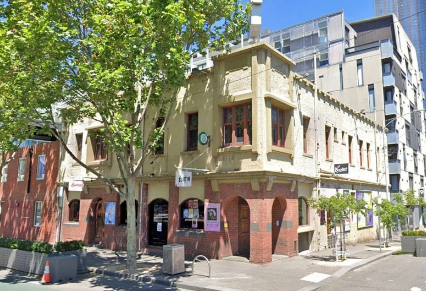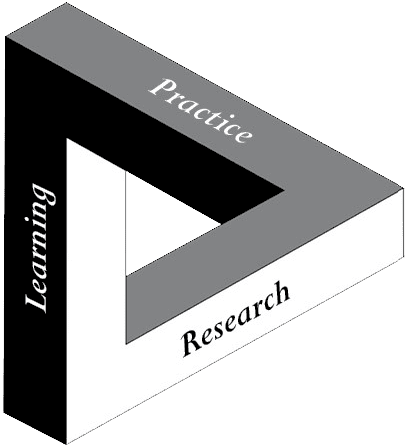This is the ninth and final instalment of my ‘sense of place’ series. Today, I reflect on the themes that I have covered during the series. I wonder: what would the urban planning profession, and urban policy development look like, if mainstream society valued places more, and understood that when we damage places, we damage ourselves?
Place attachment is a fundamental human need. It is “a secure point from which to look out on the world a firm grasp of one’s own position in the order of things and a significant spiritual and psychological attachment to somewhere in particular” (Edward Relph, from Place and Placelessness, 1976[1]).
Central to Relph’s concept of place is our recognition that people are always ‘somewhere’. Like other animals, humans are territorial. Places become territory, marked by landforms, plants, structures, picket fences or graffiti. Over time, these places are shaped, constructed, demolished, and rebuilt — often under contested circumstances. They accumulate and erode. Symbolic meanings are created and attached to places. Places may also have their own innate qualities, which people in observant cultures discern and build into their symbolic references. These symbols are then transmitted via folklore, ritual, policy, urban ordinance, and corporate branding. Dominant meanings and access to these spaces may be reinforced and protected by fencing, security guards, fines, CCTV, legislation, and urban development public-private-partnership deals deemed ‘commercial in confidence’. These days, many actors and interests are not even endemic to place – they lie offshore in hedge funds that seek to land-bank or create capital through real estate developments.
When we talk about ‘place’ and human relationships with it, we need to think of places as constellations of symbols; territorial markers; emotion; performance; power; money; ideology; tribal affiliation; individual stories and biography; dominant and minority narratives; competing perspectives and understandings; and collective narratives and folklore.
At its most extreme, neoliberal urban development treats ‘places’ as sites that can be sold for individual consumption — for example via McMansions that sit on tree-less properties; behind high walls and three drive-in garages; separated by noisy busy roads and single-purpose, low-density urban sprawl. There also may be some desultory public sculpture in front of the local Westfield, as well as some mass-produced, unengaging, risk-managed children’s playground equipment in the local pocket park.
Commenting on the relationship between placelessness and participation in planning, Relph argued that it is not that we cannot create a sense of meaning even in the blandest modern urban environments; it is that we currently participate so minimally in their creation or maintenance[2]. Consequently, as I quoted Michael Leunig in my doctoral dissertation (1999), “people live in buildings [and, by extension, neighbourhoods, towns, and cities] that inspire them or depress them, and they don’t even realise it”[3].
A key resource in replenishing treasured places is people’s ability to ‘know’ their environment (long overlooked and devalued) and their capacity to explore their interaction with it through their own senses.[4] Core to this is the need for people to participate meaningfully in planning and development decisions.
Recently, I have watched mainstream society detonate Juukan Gorge, seek to demolish sacred trees for highway duplication, knock down its own quirky architecture in St Kilda and across Melbourne, but attempt to place heritage status on the Eastern Freeway. There’s a soulless and relentless drive to dominate and profit from a place, rather than work with the community to define and nurture it for our own wellbeing. Surely the spectacular and prolific rock art on the Burrup Peninsula, which captures at least 47,000 years of traditional ownership by the Ngarda-Ngarli peoples, should be universally venerated as more than an inconvenient backdrop to extractive the fossil fuel industry? Would mainstream Australian society really allow this incomparable dreaming site, this place of worship to be destroyed within this century?
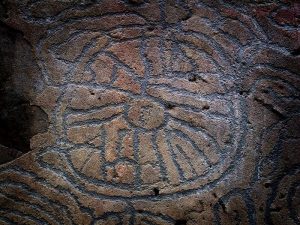
Image source: Zyance, February 2006, Cueva de Belmaco, Petroglyphen, https://commons.wikimedia.org/wiki/File:Belmaco_z12.jpg
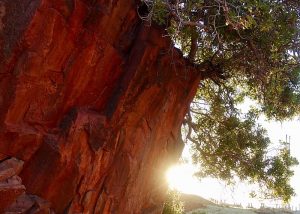
Image source: Marius Fenger, 8 May 2017, Murujuga National Park Turtle and Man carving on the rock face. NW Shelf LNG flame tower in the background, https://commons.wikimedia.org/wiki/File:Aboriginal_Rock_Art_meets_Art_of_the_Engineer.jpg
It occurs to me that ‘we’ in white Australia really need to start to embrace and understand Indigenous perspectives on ‘place’. Because I think that this is, collectively, where we need to go if we are to have any hope to reconcile our own relationship to place.
Psychologists tend to think about place identity as a feature of a person, not of a place. For other thinkers, however, places do have their own unique character or place identity, captured by the concept of ‘genius loci’ (Lewick, 2008). For poets, artists, and especially Indigenous peoples, this comes as no surprise: ‘We were born to look after this country’.
What about custodianship of place, in line with Indigenous conceptions of place and caring for Country? What about the notion that you are born into a place — and thus of that place — with an ancient ‘duty of care’ to serve it, to perform ritual to honour the spirits that created it, to care for the country, to maintain a dialogue with it, and to sing for that Country to keep it vibrant and alive?
What would our cities and suburbs, farms, mining, agriculture and indeed our planet look like, were our local, national, and planetary culture to embrace, transmit and uphold the profoundly simple statement of a collective duty of care: ‘We were born to look after this country’? Can Western notions of ‘sense of place’ even begin to comprehend the depth of this interrelationship? Can we in the West — so steeped in the myth of Adam and Eve’s disconnection from the natural world — imagine a sense of place so strong, that our selves are melded entirely within that place to the point where ‘we’ as individual beings cease to exist?
I reflect here on David Malouf’s remarkable An Imaginary Life (1979). For committing a faux pas that angered the Emperor Augustus, in 8 AD the Roman poet, Ovid, was cast into exile to the outer reaches of the Roman Empire (now Romania) at the shores of the Black Sea. Here, fated to live among a tribe of people whose language he did not speak, he chanced upon a boy living wild in the forest. I have always marvelled at Malouf’s depiction of the ‘wild’ boy’s sense of self that is melded entirely into the conscious awareness of his surroundings:
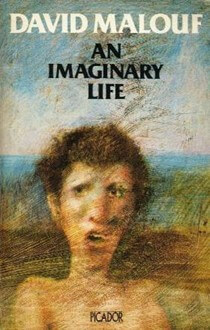 “His self is outside him, its energy distributed among the beasts and birds whose life he shares, among leaves, water, grasses, clouds, thunder – whose existence he can be at home in because they hold, each of them, some particle of his spirit. He has no notion of the otherness of things.
“His self is outside him, its energy distributed among the beasts and birds whose life he shares, among leaves, water, grasses, clouds, thunder – whose existence he can be at home in because they hold, each of them, some particle of his spirit. He has no notion of the otherness of things.
I try to precipitate myself into his consciousness of the world, his consciousness of me, but fail. My mind cannot contain him. I try to imagine the sky with all its constellations, the Dog, the Bear, the Dragon and so on, as an extension of myself, as part of my further being. But my knowing that it is sky, that the stars have names and a history, prevents my being the sky. It rains and I say, it rains. It thunders and it says, it thunders. The Child is otherwise. I try to think as he must: I am raining, I am thundering, and am immediately struck with panic, as if in losing hold of my separate and individual soul, in shaking the last of it off from the tip of my little finger, I might find myself lost out there in the multiplicity of things, and never get back.
David Malouf, An Imaginary Life (Pages 95-96)
References
Would urban planning even need to exist as a profession (certainly the one that seeks to ‘balance the conflicting demands of social equity, economic growth, environmental sensitivity, and aesthetic appeal’), if all of us humans could be this integrated into our surrounding places?
[1] Cited in Williams, D. R., & Miller, B. A. (2021), Metatheoretical moments in place attachment research: Seeking clarity in diversity, in L. Manzo & P. Devine-Wright, Place attachment: Advances in theory, methods and applications (2nd ed.), pp. 13-28. Oxford: Taylor & Francis Group. Quotation from p. 17
[2] Relph, E. (1976). Place and placelessness. London: Pion Ltd.
[3] Michael Leunig, cited in Beck, C. (1998, July-August). Leunig on the loose. HQ Magazine, 59, 60-66. Quotation from p. 65.
[4] Hiss, T. (1990). The experience of place. New York: Alfred A. Knopf.

